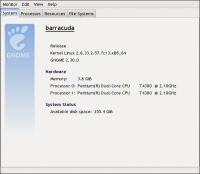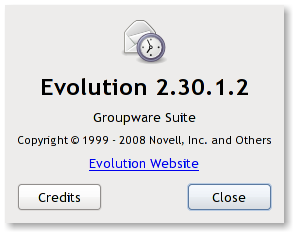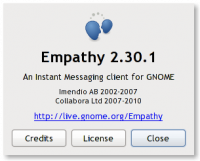| Line 21: | Line 21: | ||
== Desktop Environment == | == Desktop Environment == | ||
{{Quote|In graphical computing, a desktop environment (DE) commonly refers to a style of graphical user interface (GUI) that is based on the desktop metaphor which can be seen on most modern personal computers today.[1] Almost universally adopted in modern computers,[2] these graphical interfaces are designed to assist the user in easily accessing and configuring (or modifying) the most important (or frequently accessed) specific Operating System (OS) packed features, yet it is not meant to give access to the whole vast feature set found in an OS, reason for which the traditional, yet less intuitive,[citation needed] command-line interface (CLI) is still in use when full control over the OS is required. | |||
A desktop environment typically consists of icons, windows, toolbars, folders, wallpapers,shortcuts and desktop widgets. (See WIMP). [3] | |||
Software which provides a desktop environment might also provide drag and drop functionality and other features which make the desktop metaphor more complete. On the whole, a desktop environment is to be an intuitive way for the user to interact with the computer using concepts which are similar to those used when interacting with the physical world, such as buttons and windows.| [http://en.wikipedia.org/wiki/Desktop_environment Desktop Environment by Wikipedia], 1st May 2010}} | |||
== Communications == | == Communications == | ||
Revision as of 14:23, 1 May 2010
Introduction

The Fedora Project provides a Linux distribution named "Fedora", having scheduled it's 13th Release, Fedora 13 "Goddard", to 18th May 2010. One of the features that Fedora 13 deploys is the long waited GNOME 2.30.0, the Free Software Desktop Project maintained and promoted by the GNOME Foundation and part of the GNU Project.
Fedora 13 introduces to it's users a new set of features and in some cases extended functionality. Some of this features are a part of the GNOME Desktop and provide a more pleasant Linux experience to Fedora and GNOME users. Amongst this features we can highlight GNOME Colour Management and NetworkManager which presents extended features such as: DHCPv6, Bluetooth DUN and Mobile Broadband Status.
Red Hat Inc. is the official sponsor of the Fedora Project, and also sponsors the GNOME Project alongside with other Industry leaders which can be consulted in the GNOME Foundation webpage.
GNOME in Fedora 13
A User's perspective
Everyday millions of people use Linux and GNOME to accomplish very different tasks; to communicate with others, to develop work in many distinct ways and for leisure. During this article we will present some of the most popular GNOME applications to the most common tasks.
Desktop Environment
Desktop Environment by Wikipedia, 1st May 2010 |
Communications
Personal Computers are widely used for communicating with others. GNOME provides applications that will meet most users needs to accomplish this tasks in a very friendly way, either for regular users or advanced users. There are many projects that offer good integration with GNOME, being the most popular:
- Evolution - an e-mail, address book and calendaring application that offers outstanding functionality either for regular or more demanding users.
- Empathy - one of the favourite Instant Messaging clients amongst GNOME users, being rivalled by Pidgin.
- Ekiga - formerly known as GnomeMeeting, a video conferencing and softphone application that also provides IM capabilities.
- X-Chat - X-Chat is a very popular IRC client which provides a very clean and easy to use interface and integration capabilities.
Fedora and GNOME users will have no problems finding applications to handle their communication needs of every day. Bellow is a simple review of some of the most popular applications for this purpose available for the GNOME Desktop in Fedora 13 "Goddard".
Evolution

Evolution provides integrated mail, address book and calendaring functionality to the GNOME Desktop. Evolution has an extensive feature list and very accurate documentation besides being able to answer to most people's needs.

Evolution offers a very intuitive Wizard for the initial configuration that in a couple of minutes allows it's users to easily set-up their e-mail account using the most popular protocols. In addition also provides a very intuitive address book and a powerful calendaring experience. There are a wide set of plugins available, delivering extended functionality into Evolution.
Evolution is a reference amongst e-mail clients available for Linux and ships with GNOME 2.30.0 on Fedora 13.
Empathy

Empathy is GNOME's default Instant Messaging Client and supports text, voice, video and file transfers over many different protocols, alongside with a very distinct list of features. Amongst the supported protocols we can find: Google Talk, MSN/Live, AIM, Facebook, Yahoo!, ICQ, etc.
There is a wide offer for IM Clients, and Empathy competes directly with Pidgin which is a popular choice amongst GNOME users, also providing very similar features.
Ekiga
Ekiga is an open source SoftPhone, Video Conferencing and Instant Messenger application with very an extend feature list.
Multimedia
Totem
Rythmbox
Brasero
Graphics Manipulation
The Gimp
Inkscape
System Tools
Nautilus
GNOME Terminal
GNOME Control Panel
GNOME System Monitor
GPK Application
Production
Gobby
Gedit
Personal Review
Testimonials
Neville A. Cross, Fedora Marketing Team |
Nelson Marques, Fedora Marketing Team |
Rahul Sundaram, Fedora Developer |
Henrik Heigl, Fedora Ambassador and Fedora Marketing Team |

